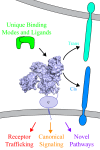Neuropilin Functions as an Essential Cell Surface Receptor
- PMID: 26451046
- PMCID: PMC4705917
- DOI: 10.1074/jbc.R115.687327
Neuropilin Functions as an Essential Cell Surface Receptor
Abstract
The Neuropilins (Nrps) are a family of essential cell surface receptors involved in multiple fundamental cellular signaling cascades. Nrp family members have key functions in VEGF-dependent angiogenesis and semaphorin-dependent axon guidance, controlling signaling and cross-talk between these fundamental physiological processes. More recently, Nrp function has been found in diverse signaling and adhesive functions, emphasizing their role as pleiotropic co-receptors. Pathological Nrp function has been shown to be important in aberrant activation of both canonical and alternative pathways. Here we review key recent insights into Nrp function in human health and disease.
Keywords: VEGFR; angiogenesis; heparin-binding protein; neuropilin; protein-protein interaction; receptor structure-function; semaphorin; vascular endothelial growth factor (VEGF).
© 2015 by The American Society for Biochemistry and Molecular Biology, Inc.
Figures




References
-
- Kawasaki T., Kitsukawa T., Bekku Y., Matsuda Y., Sanbo M., Yagi T., and Fujisawa H. (1999) A requirement for neuropilin-1 in embryonic vessel formation. Development 126, 4895–4902 - PubMed
-
- Kitsukawa T., Shimono A., Kawakami A., Kondoh H., and Fujisawa H. (1995) Overexpression of a membrane protein, neuropilin, in chimeric mice causes anomalies in the cardiovascular system, nervous system and limbs. Development 121, 4309–4318 - PubMed
-
- Carmeliet P., Ferreira V., Breier G., Pollefeyt S., Kieckens L., Gertsenstein M., Fahrig M., Vandenhoeck A., Harpal K., Eberhardt C., Declercq C., Pawling J., Moons L., Collen D., Risau W., and Nagy A. (1996) Abnormal blood vessel development and lethality in embryos lacking a single VEGF allele. Nature 380, 435–439 - PubMed
Publication types
MeSH terms
Substances
Associated data
- Actions
- Actions
- Actions
- Actions
- Actions
Grants and funding
LinkOut - more resources
Full Text Sources
Other Literature Sources
Miscellaneous

